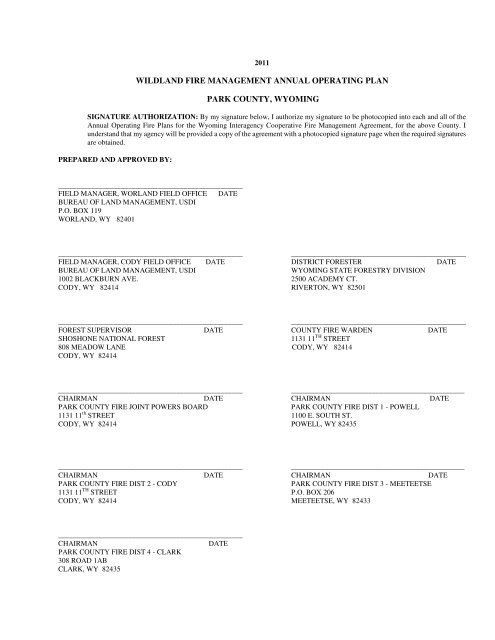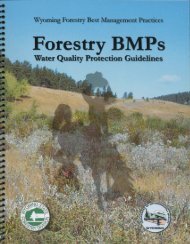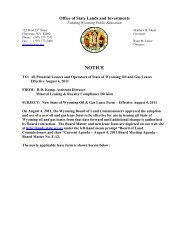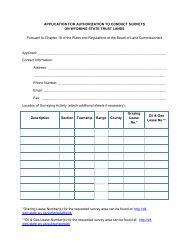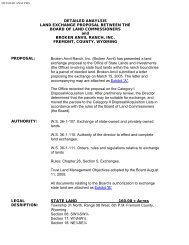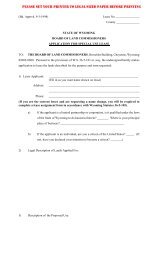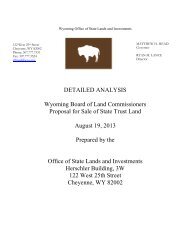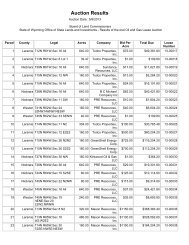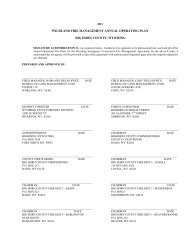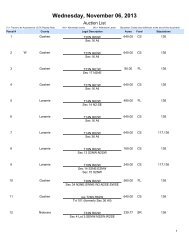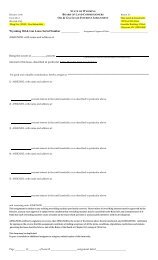wildland fire management annual operating plan park county ...
wildland fire management annual operating plan park county ...
wildland fire management annual operating plan park county ...
Create successful ePaper yourself
Turn your PDF publications into a flip-book with our unique Google optimized e-Paper software.
2011<br />
WILDLAND FIRE MANAGEMENT ANNUAL OPERATING PLAN<br />
PARK COUNTY, WYOMING<br />
SIGNATURE AUTHORIZATION: By my signature below, I authorize my signature to be photocopied into each and all of the<br />
Annual Operating Fire Plans for the Wyoming Interagency Cooperative Fire Management Agreement, for the above County. I<br />
understand that my agency will be provided a copy of the agreement with a photocopied signature page when the required signatures<br />
are obtained.<br />
PREPARED AND APPROVED BY:<br />
__________________________________________________<br />
FIELD MANAGER, WORLAND FIELD OFFICE DATE<br />
BUREAU OF LAND MANAGEMENT, USDI<br />
P.O. BOX 119<br />
WORLAND, WY 82401<br />
__________________________________________________<br />
_________________________________________________<br />
FIELD MANAGER, CODY FIELD OFFICE DATE DISTRICT FORESTER DATE<br />
BUREAU OF LAND MANAGEMENT, USDI<br />
WYOMING STATE FORESTRY DIVISION<br />
1002 BLACKBURN AVE. 2500 ACADEMY CT.<br />
CODY, WY 82414 RIVERTON, WY 82501<br />
__________________________________________________<br />
_________________________________________________<br />
FOREST SUPERVISOR DATE COUNTY FIRE WARDEN DATE<br />
SHOSHONE NATIONAL FOREST<br />
1131 11 TH STREET<br />
808 MEADOW LANE CODY, WY 82414<br />
CODY, WY 82414<br />
__________________________________________________<br />
_______________________________________________<br />
CHAIRMAN DATE CHAIRMAN DATE<br />
PARK COUNTY FIRE JOINT POWERS BOARD<br />
PARK COUNTY FIRE DIST 1 - POWELL<br />
1131 11 th STREET 1100 E. SOUTH ST.<br />
CODY, WY 82414 POWELL, WY 82435<br />
__________________________________________________<br />
_______________________________________________<br />
CHAIRMAN DATE CHAIRMAN DATE<br />
PARK COUNTY FIRE DIST 2 - CODY<br />
PARK COUNTY FIRE DIST 3 - MEETEETSE<br />
1131 11 TH STREET P.O. BOX 206<br />
CODY, WY 82414 MEETEETSE, WY 82433<br />
__________________________________________________<br />
CHAIRMAN<br />
DATE<br />
PARK COUNTY FIRE DIST 4 - CLARK<br />
308 ROAD 1AB<br />
CLARK, WY 82435
2<br />
ANNUAL OPERATING PLAN<br />
This Plan is between the USDI Bureau of Land Management (BLM), Wyoming State Forestry Division<br />
(WSFD), USDA Forest Service (USFS), Park County, Park County Fire Districts Joint Powers Board, and<br />
Park County Fire Districts - 1,2,3,4.<br />
All Federal, State, and County Agencies may hereinafter be jointly referred to as the "Agencies".<br />
A. AUTHORITY:<br />
Wyoming Interagency Cooperative Fire Management Agreement USDA Forest Service # 07-FI-<br />
11020000-018 and USDI Bureau of Land Management # KAA 020003.<br />
B. PURPOSE:<br />
To outline details of implementing the Wyoming Interagency Cooperative Fire Management<br />
Agreement, NUMBERS KAA 020003 AND 07-FI-11020000-018 and the Wyoming Interagency Fire<br />
Protection Agreement.<br />
C. FIRE PROTECTION RESPONSIBILITIES & PRIORITIES:<br />
Each agency will retain initial attack responsibility for lands under their protection responsibility.<br />
1. Reciprocal Fire Protection Services (Mutual Aid)<br />
Zone Description: All private, State, and Federal lands within Park County.<br />
a. Within the reciprocal <strong>fire</strong> protection zone, each agency shall assume<br />
its own full cost of expenditures for a maximum of six (6) hours<br />
following the initial dispatch. Costs incurred after the reciprocal <strong>fire</strong><br />
protection period ends will be reimbursed by the protecting agency.<br />
The protecting agency will be determined as soon as possible. All<br />
<strong>fire</strong>s will be reported to the protecting agency.<br />
b. Reciprocal protection is not construed as an automatic six (6) hour<br />
dispatch. Therefore, priority will be given to the release of a<br />
supporting agency when it is mutually agreed upon by the initial<br />
attack forces that the <strong>fire</strong> situation is such that the protecting agency's<br />
forces on the scene can adequately control the incident. Furthermore,<br />
within its capabilities, the protecting agency will render support to the<br />
supporting agency to include but not limited to food, water, and<br />
additional forces to expedite release of the supporting agency in<br />
advance of the maximum six (6) hour reciprocal <strong>fire</strong> protection.
3<br />
BLM LAND<br />
Immediate suppression action will be taken by the co<strong>operating</strong> parties within<br />
their capabilities. Immediate notification of all <strong>fire</strong>s either on or threatening<br />
BLM lands will be given to the CIDC at (1-800-295-9954).<br />
The BLM will participate in Reciprocal Fire Protection Services.<br />
BOR LAND<br />
STATE LAND<br />
Wild<strong>fire</strong>s on Bureau of Reclamation lands are protected by the BLM.<br />
All suppression actions will be reported to the CIDC (1-800-295-9954) on<br />
discovery of a <strong>fire</strong> which may threaten or directly impact BOR lands.<br />
Fires within one mile of BOR land are considered a threat to BOR and will be<br />
reported to CIDC.<br />
Immediate suppression action will be taken by the co<strong>operating</strong> agencies<br />
within their capabilities. Each <strong>fire</strong> district will have primary responsibility<br />
for initial attack on State lands within their district. Immediate notification of<br />
all <strong>fire</strong>s either on or threatening State lands will be given to the Park County<br />
Sheriff’s Dispatch at 527-8700 and CIDC. Notification of <strong>fire</strong>s on State lands<br />
will be reported promptly to a representative of Wyoming State Forestry<br />
Division listed in the attached service directory.<br />
The State or its representative suppression forces will participate in<br />
Reciprocal Fire Protection Services.<br />
NATIONAL FOREST<br />
Unless directed otherwise by an agency representative, immediate<br />
suppression action may be taken by the co<strong>operating</strong> agencies within their<br />
capabilities. Immediate notification of all <strong>fire</strong>s either on or threatening<br />
National Forest Service lands will be given to the CIDC at (1-800-295-9954).<br />
All <strong>fire</strong>s within one (1) mile of the National Forest Boundary may be<br />
considered as threatening National Forest land and the U.S. Forest Service<br />
determine the appropriate response. For all other lands in Park County, the<br />
Forest Service will provide suppression services within current capabilities as<br />
requested.
4<br />
PRIVATE LANDS<br />
Immediate suppression action will be taken by the co<strong>operating</strong> agencies<br />
within their capabilities. Immediate notification of all <strong>fire</strong>s either on or<br />
threatening private lands or private property will be given to the Park County<br />
Sheriff’s Dispatch at 527-8700.<br />
2. Reimbursable Fire Protection Services<br />
Zone Description: The entire <strong>county</strong> is considered a reimbursable <strong>fire</strong> protection<br />
zone after the initial six (6) hour reciprocal period or as agreed upon by the<br />
Protecting and Supporting agency.<br />
3. Offset or Exchange<br />
None identified.<br />
4. Protection Area Maps<br />
Each agency will provide a Protection Area Map as an attachment to this Annual<br />
Operating Plan.<br />
5. Community Wild<strong>fire</strong> Protection Plans (CWPP)<br />
On <strong>fire</strong>s that threaten, or involve the Wildland Urban Interface, the respective<br />
County’s Community Wild<strong>fire</strong> Protection Plan shall be referred to for suppression<br />
priorities and other information that could prove beneficial to the suppression efforts.<br />
D. SPECIAL MANAGEMENT CONSIDERATIONS:<br />
1. FEDERAL LANDS<br />
No dozer use is allowed on Federal land unless authorization is given by a Federal<br />
representative.<br />
Wilderness Study Areas (WSA) and Areas of Critical Environmental Concern<br />
(ACEC) measures, constraints and WSA/ACEC maps are provided as an<br />
attachment to the Annual Operating Plan.<br />
E. WILDFIRE MANAGEMENT PROCEDURES:<br />
1. NOTIFICATION<br />
All <strong>fire</strong>s and initial action will be reported promptly to the protecting agency and<br />
further instructions agreed upon. Upon notification, if the protecting agency fails to<br />
properly recognize and claim ownership, suppression costs for the protecting agency's<br />
proportionate share will be assessed them upon discovering and proof of ownership
5<br />
by the supporting agency.<br />
For list of contacts for notification or requests of assistance see the directory.<br />
A <strong>fire</strong> report shall be submitted to the protecting agency within 15 days after the <strong>fire</strong><br />
is declared out.<br />
2. INITIAL ATTACK<br />
If one or more parties to this agreement arrive on initial attack, the first agency on the<br />
scene will assume command and may turn the responsibility over to another agency if<br />
they have more qualified supervisory personnel and the complexity of the incident<br />
requires a higher level of supervision. Once protection responsibilities are<br />
established, the protecting agency(s) will either assume command or direct a<br />
supporting agency to do so. Jurisdiction and safety considerations make it necessary<br />
that the most qualified supervisory personnel assume command or agree to<br />
implement Unified Command of a multi-jurisdictional <strong>fire</strong>.<br />
3. ESCAPED FIRES OR FIRES THREATENING OTHER JURISDICTIONS<br />
Field personnel, involved in <strong>fire</strong> suppression action, will contact the other protecting<br />
agencies as soon as possible after a <strong>fire</strong> escapes or threatens to escape initial attack<br />
near intermingled ownership (defined as different ownership within 1 mile of the <strong>fire</strong><br />
or it is anticipated that other ownerships may be involved) and a Unit Administrator<br />
Group will be assembled by the initial attack agency to represent the protecting<br />
agencies involved with that <strong>fire</strong>.<br />
a. Guidelines for assembling the Unit Administrator Group:<br />
- A wild<strong>fire</strong> that escapes initial attack or is a threat to other<br />
jurisdictions.<br />
- A Type III or higher incident <strong>management</strong> team (IMT) is dispatched<br />
or ordered.<br />
- Control is not anticipated before the next burning period.<br />
- Suppression expenditures are expected to exceed $15,000.00<br />
b. The Unit Administrator Group's function is:<br />
- To participate in development and approval of <strong>wildland</strong> <strong>fire</strong> decision<br />
documents developed for managing a <strong>fire</strong> incident.<br />
- To recommend to the appropriate Line Officer(s) the level at which<br />
the Incident should be managed.
- To prepare a Delegation of Authority for Line Officer(s) signature.<br />
- To act as the agency representative for their respective agency.<br />
- To develop incident <strong>management</strong> objectives and agree on <strong>management</strong><br />
actions needed.<br />
- To recommend to the line officers the <strong>management</strong> level (Type 1, 2,<br />
or 3) and command structure (Unified or single IC) appropriate for the<br />
incident. This recommendation will be based upon complexity,<br />
ownership, values to be protected, and qualifications of personnel.<br />
- To develop a written cost share agreement for Line Officer(s) approval<br />
signatures (Example - Exhibit H in the Wyoming Mini Mobilization<br />
Guide).<br />
To prepare an IMT in-briefing, if an IMT has been ordered.<br />
- To agree to all expenditures whenever the suppression <strong>plan</strong> must be<br />
modified, including mop-up, rehab and patrol after demobilization of<br />
the <strong>fire</strong>.<br />
(1) The Incident Commander/Unified Command will provide the<br />
Unit Administrator Group with an estimated <strong>fire</strong> cost daily.<br />
(2) The Incident Commander/Unified Command and the Unit<br />
Administrator Group will reach mutual agreement when the<br />
<strong>fire</strong> situation is such that the group can be demobilized.<br />
For list of the designated representatives for purposes of a Unit Administrator Group<br />
see the directory.<br />
4. FIREFIGHTER QUALIFICATIONS<br />
Three levels of expertise are recognized.<br />
1. Within jurisdiction the qualifications for local resources utilized for<br />
initial attack <strong>fire</strong> suppression within that respective <strong>county</strong> will meet<br />
local standards.<br />
2. Outside of jurisdiction, engine dispatch will consist of a minimum of<br />
one NWCG 310-1 qualified Engine Boss (ENGB) and one NWCG<br />
310-1 qualified Firefighter Type 2 (FFT2) per engine. Certification<br />
will be the responsibility of the sending agency.<br />
3. All <strong>county</strong> and State Unit Leader positions and above will be NWCG<br />
310-1 qualified. Certification is the responsibility of Wyoming State<br />
Forestry Division/agency.<br />
6
7<br />
F. AVIATION PROCEDURES<br />
RETARDANT<br />
1. Aerial retardants may be used with prior approval of the protecting agency unless<br />
otherwise specified under "Special Management Considerations" of this <strong>plan</strong>. For list<br />
of contacts for retardant usage approval see the directory.<br />
2. Aerial retardants will be paid for by the requesting agency if prior approval has not<br />
been obtained.<br />
3. Air to air and air to ground frequencies with designated ground contacts need to be<br />
established with dispatch. All agencies will utilize the standard Air to Ground naming<br />
convention adopted by the Rocky Mountain Area in 2011.<br />
4. Aircraft under contract with Wyoming State Forestry Division should be dispatched<br />
through CIDC. Zone dispatch will coordinate dispatches with the Wyoming State<br />
Forestry Duty Officers.<br />
5. Helicopter use will be requested through the CIDC. See call list.<br />
G. ENFORCEMENT<br />
RESTRICTIONS AND CLOSURES<br />
1. Fire Restrictions and/or Closures will be coordinated between the parties to this<br />
agreement to include initiating, implementing, and lifting. Reference Wyoming<br />
Interagency Fire Restriction Plan<br />
FIRE INVESTIGATIONS<br />
Each agency is responsible for investigating and taking appropriate action for all <strong>fire</strong>s on lands<br />
under their jurisdiction. The initial attack Incident Commander will take all responsible<br />
precautions to preserve evidence found.<br />
H. FUEL MANAGEMENT AND PRESCRIBE FIRE CONSIDERATIONS<br />
1. Fuel <strong>management</strong> and prescribed <strong>fire</strong> projects will be coordinated with the parties to<br />
this agreement.<br />
2. Wild<strong>fire</strong>s resulting from escaped prescribed <strong>fire</strong> incidents, at the direction or under the<br />
supervision of one of the agencies to this agreement, shall be the responsibility of that<br />
agency. All incident <strong>management</strong> costs, exclusive of reciprocal periods, shall be<br />
borne by the responsible party. The responsible agency on Federal lands shall be the<br />
jurisdictional agency. An agency may take appropriate suppression action when lands
under its protection responsibility are involved in or threatened by the <strong>fire</strong>. Such<br />
suppression action may be taken on its own initiative or at the request of the<br />
responsible agency. An agency may take appropriate suppression action, at the<br />
request of the responsible agency, when lands under its protection are not involved in<br />
or threatened by the <strong>fire</strong>. The responsible agency shall reimburse the other agencies for<br />
all suppression costs incurred in accordance with this clause.<br />
3. Escaped prescribed <strong>fire</strong>s ignited by individual(s) not party to this agreement will be<br />
considered as wild<strong>fire</strong>s requiring suppression action under the terms and conditions of<br />
this agreement.<br />
4. Agencies agree to share and reimburse, according to the rates established in exhibits<br />
C, D, E, and F for resources used on prescribed <strong>fire</strong> projects, based on availability,<br />
qualifications, and need.<br />
I. REIMBURSEMENTS BY PROTECTING AGENCY<br />
1. An itemized bill (for example see exhibit B) and supporting documentation, for<br />
reimbursable services or services provided for prescribed <strong>fire</strong> will be provided to the<br />
protecting agency within 60 days after the <strong>fire</strong> is declared out. If the total cost is not<br />
known at the time of initial billing, a partial bill, so identified, may be submitted. A<br />
final bill, so identified, will be issued within six months after the <strong>fire</strong> is declared<br />
controlled. Bills will contain the protecting agency's <strong>fire</strong> number and name, resource<br />
order number, and inclusive dates. Billing for incidents within the State of Wyoming<br />
will be submitted to the local protecting host unit. The lead agency will be responsible<br />
for the final <strong>fire</strong> financial packet and coordination of payments. Only original<br />
invoices will be utilized for payment. Send bill to the agency representative listed in<br />
the directory.<br />
2. In situations where a burn area encompasses land under the protection or jurisdictional<br />
responsibility of more than one agency, a cost share agreement will be implemented<br />
before billing.<br />
3. Nothing herein shall prohibit any agency, on its own initiative and without notifying<br />
the protecting agency and without reimbursement, from going upon lands known to be<br />
protected by another agency to engage in suppression of wild<strong>fire</strong>s, when such <strong>fire</strong>s are<br />
a threat to lands within that agency's protection responsibility.<br />
4. Salaries for Agency employees will be paid at the established rate in effect at the time<br />
of the <strong>fire</strong>.<br />
5. Salaries for other than Agency employees will be applicable FF rate(s) established<br />
<strong>annual</strong>ly for Wyoming. (Exhibit F in the Wyoming Mini Fire Mobilization Plan)<br />
6. All Agency equipment will be reimbursed at the rates established in Exhibit C of the<br />
Wyoming Mini Fire Mobilization Plan.<br />
8
9<br />
7. All supporting agencies shall be subject to examination and audit for three (3) years<br />
after final payment.<br />
J. GENERAL PROCEDURES<br />
1. This <strong>plan</strong> becomes effective on the date signed by each agency. It may be terminated<br />
upon 20 days written notice from one party to the other.<br />
This <strong>plan</strong> will remain in effect until updated or terminated. Target date for <strong>annual</strong><br />
update is April 15. Wyoming State Forestry Division will take the lead in getting this<br />
Plan prepared <strong>annual</strong>ly.<br />
2. The agencies agree to requirements of the CIDC AOP. The agencies give authority to<br />
the CIDC to provide the services required in support of the centers charter and<br />
<strong>operating</strong> <strong>plan</strong>. For specifics, see the CIDC AOP.<br />
K. OTHER CONSIDERATIONS<br />
1. WILDLAND URBAN INTERFACE PROTECTION<br />
Structural <strong>fire</strong> suppression is the responsibility of tribal or the local <strong>fire</strong> service entity.<br />
Keeping an approaching wild<strong>fire</strong> from reaching a structure may be the responsibility of any<br />
parties to this agreement depending upon the location of the wild<strong>fire</strong> and the chosen<br />
<strong>management</strong> strategy.<br />
Private Lands – Cost associated with the protection of privately owned land and structures<br />
are the responsibility of the local <strong>fire</strong> service entity that has jurisdiction for the private<br />
property.<br />
Federal Lands w/Private Structures - Costs associated with the protection of privately<br />
owned structures on federal lands are the responsibility of the local <strong>fire</strong> service entity that has<br />
jurisdiction for the private structures. Structure protection responsibilities of the local <strong>fire</strong><br />
service entity include actions taken directly on the structure or the immediate area surrounding<br />
structure. The federal agencies will be responsible for costs associated with keeping the <strong>fire</strong><br />
from reaching the structures<br />
Agencies that elect not to suppress an ignition with intent to manage the <strong>fire</strong> for resource<br />
benefits are responsible for the cost associated with that <strong>fire</strong>. This includes the cost of<br />
protecting private land, structures and infrastructure, as well as other State and Federal<br />
managed lands, unless negotiated otherwise with the other affected jurisdictions. For<br />
incidents that have an initial response objective of protection (suppression) and it is later<br />
determined that there is also an opportunity to effectively manage a portion of the incident for<br />
resource benefit objectives, agencies should follow the standard cost share principles and<br />
may need to develop additional cost share agreements based on changes in the situation and<br />
objectives.
The local <strong>fire</strong> service entity is responsible for developing structure protection <strong>plan</strong>s and<br />
coordinating with the incident <strong>management</strong> team to implement the <strong>plan</strong>. This could include<br />
the local <strong>fire</strong> service entity preparing the <strong>plan</strong> themselves or working with the incident<br />
<strong>management</strong> team to obtain resources to prepare and implement the <strong>plan</strong>. The local <strong>fire</strong><br />
service entity is responsible for determining any actions to be applied directly to a structure<br />
such as wrapping; applying foam, <strong>fire</strong> gels, or other retardants; sprinklers on roofs, etc.<br />
10<br />
2. RADIO FREQUENCIES<br />
Communication frequencies to be used for initial attack:<br />
Rx freq Rx CG Tx freq Tx CG<br />
North Zone WY Fire Zone<br />
BLM –Base Channel 168.525 168.525<br />
Scene of Action 166.0875 166.0875<br />
Cedar Mountain Rpt 168.525 172.4375 123.0<br />
Black Mountain Rpt 168.525 172.4375 110.9<br />
Wyoming State Forestry 151.160 151.160<br />
Fire 154.280 154.280<br />
USFS - Shoshone Forest<br />
(North Zone) 170.500 170.500 110.9<br />
Dead Indian, Sunlight 170.500 166.5625 156.7<br />
Wood Ridge, Meeteese170.500 166.5625 103.5<br />
Clayton Mtn., N. Fork 170.500 166.5625 131.8<br />
Carter Mtn., S. Fork 170.500 166.5625 146.2<br />
Clay Butte, Crandall 170.500 166.5625 123.0<br />
Cody Fire 155.895 153.875 100.0<br />
Park County SO 155.790 155.790<br />
All agencies will utilize the standard Air to Ground naming convention adopted by the Rocky<br />
Mountain Area in 2011.<br />
GLOSSARY
11<br />
Agency:<br />
State, <strong>county</strong> and federal cooperators.<br />
Area of Critical Environmental Concern (ACEC):<br />
An area of public lands where special <strong>management</strong> attention is required to protect and<br />
prevent irreparable damage to important historic, cultural, or scenic values, fish and<br />
wildlife resources, or other natural system or processes, or to protect life or provide<br />
safety from natural hazards.<br />
County:<br />
County and local <strong>fire</strong> service entities.<br />
County and local <strong>fire</strong> service entities:<br />
County Fire Organizations, City Fire Organizations, Joint Powers Boards, or Fire<br />
Protection Districts.<br />
Initial Attack:<br />
The control efforts taken by resources which are the first to arrive at the incident.<br />
Jurisdictional Agency:<br />
The Agency or County which has overall land and resource <strong>management</strong> and/or<br />
protection responsibility as provided by Federal or State law.<br />
Line Officer:<br />
Individual who has been delegated full authority to make decisions on all matters<br />
affecting that agency's participation at the incident.<br />
Prescribed Fire:<br />
The <strong>plan</strong>ned and/or permitted use of <strong>fire</strong> to accomplish specific land <strong>management</strong><br />
objectives.<br />
Protecting Agency:<br />
The Agency or County responsible for providing direct wild<strong>fire</strong> protection to a given<br />
area pursuant to the Wyoming Interagency Fire Protection Agreement and the<br />
Wyoming Interagency Cooperative Fire Management Agreement.<br />
Protection Area Maps:<br />
Official maps of the <strong>annual</strong> <strong>operating</strong> <strong>plan</strong>s. Example: Maps showing protection area<br />
responsibilities.<br />
Reciprocal Fire Protection:<br />
A Supporting Agency will take initial attack in support of the Protecting Agency. The<br />
Protecting Agency will not be required to reimburse the Supporting Agency for costs<br />
incurred following the initial dispatch of any ground resources to the <strong>fire</strong> for the<br />
duration of the reciprocal period as defined in this <strong>plan</strong>, not to exceed 24 hours.
12<br />
DIRECTORY<br />
Reimbursable Fire Protection:<br />
Fire suppression resources will be paid for by the requesting Protecting Agency per<br />
the conditions in the Wyoming Interagency Fire Protection Agreement, Wyoming<br />
Interagency Cooperative Fire Management Agreement and this Annual Operating<br />
Plan.<br />
Suppression:<br />
All the work of confining and extinguishing a <strong>fire</strong> beginning with its discovery<br />
through the conclusion of the incident.<br />
Supporting Agency:<br />
An Agency or County providing <strong>fire</strong> suppression or other support and resources to the<br />
Protecting Agency.<br />
Unit Administrator Group:<br />
A group consisting of two or more individuals assigned administrative responsibilities<br />
to make coordinating decisions and recommendations within the framework of the<br />
Annual Operating Plan.<br />
Wilderness Study Area (WSA):<br />
A roadless area which has been found to have wilderness characteristics.<br />
Wild<strong>fire</strong>:<br />
An unwanted <strong>wildland</strong> <strong>fire</strong> not designated and managed as a prescribed <strong>fire</strong>, and<br />
requiring appropriate suppression action. (From USFS – Forest Service Handbook<br />
5109.14 Sec. 5)<br />
Wildland Fire:<br />
Any non-structure <strong>fire</strong>, other than prescribed <strong>fire</strong>, that occurs in the <strong>wildland</strong>.<br />
Wild<strong>fire</strong> Situation Analysis (WFSA):<br />
A decision making process that evaluates alternative <strong>management</strong> strategies against<br />
selected safety, environmental, social, economical, political, and resource<br />
<strong>management</strong> objectives as selection criteria.<br />
Wild<strong>fire</strong> Use:<br />
Within the <strong>fire</strong> use program, <strong>fire</strong>s that are ignited by natural means are permitted to<br />
burn under specific environmental conditions, in pre-<strong>plan</strong>ned locations, with adequate<br />
<strong>fire</strong> <strong>management</strong> personnel and equipment available to meet defined objectives.<br />
Listed below are the Agency positions in order of authority for decisions within each Agency.<br />
For purpose of notification, request of assistance, approval of retardant or equipment use, and<br />
for representatives for the Unit Administrator Group use the call list which is arranged
according to the order each Agency wants their representatives called. Each Agency<br />
representative will be responsible to follow the proper procedure for their Agency.<br />
BLM Lands - District Fire Management Officer/Field Office Manager or their<br />
designated representative.<br />
BOR Lands- BLM District Fire Management Officer/Field Office Manager or their<br />
designated representative.<br />
State Lands - Assistant State Forester - Fire Management/District Forester/Duty<br />
Officer or their designated representative.<br />
National Forest Lands - District Ranger/Forest Fire Management Officer or their<br />
designated representative.<br />
BIA Lands - Fire Management Officer or their designated representative.<br />
National Park Service Lands - Fire Management Officer/Chief Ranger or their<br />
designated representative.<br />
U.S. Fish & Wildlife Service Lands - Manager or their designated representative.<br />
Private Lands - County Commissioner, District Fire Board, County Fire Warden, or<br />
their designated representative.<br />
Agency Representatives<br />
a. Chuck Russell- Wind River/Big Horn Basin BLM, Cody, Worland, Lander<br />
Field Offices and BOR<br />
Frank Keeler – High Desert District BLM, Rock Springs, Kemmerer, Pinedale<br />
and Rawlins Field Offices.<br />
b. Russ Wenke - Park County<br />
c. Paul Morency - Wyoming State Forestry Division, Riverton Office<br />
d. Mark Giacoletto - USFS, Shoshone National Forest<br />
The above individuals will represent the participating agencies when a Unit Administrator<br />
Group is needed.<br />
13<br />
2011
14<br />
ANNUAL OPERATING PLAN CONDENSED FIRE DIRECTORY<br />
BUREAU OF LAND MANAGEMENT<br />
(B) 578-5740<br />
Cody Interagency Dispatch Center (B) 1-800-295-9954<br />
Cathy Hutton, Center Manager<br />
cathy_hutton@blm.gov<br />
Paging Service/Answering Service 1-800-295-9954<br />
Wind River/Big Horn Basin District<br />
Chuck Russell, Zone FMO<br />
Ryan Sundberg, District AFMO Operations<br />
Chuck_Russell@blm.gov<br />
(H) 347-7988<br />
(B) 347-5213<br />
(C) 388-5144<br />
Ryan_Sundberg@blm.gov<br />
(B) 347-5188<br />
(C) 388-5188<br />
Rance Neighbors, District AFMO Fuels<br />
Rance_Neighbors@blm.gov<br />
(B) 347-5148<br />
(B) 431-9878<br />
High Desert District<br />
Frank Keeler, District FMO (B) 352-0282<br />
(C) 350-6994<br />
Richard Putnam, District AFMO Fuels (B) 352-0282<br />
(C) 350-2207<br />
WYOMING STATE FORESTRY DIVISION<br />
Paul Morency, District Forester<br />
Brian Russell, Assistant DF<br />
pmoren@wyo.gov<br />
(H) 856-0366<br />
(B) 856-8655<br />
(C) 851-1482<br />
brusse3@wyo.gov<br />
(H) 406-370-1977<br />
(B) 856-8655<br />
(C) 851-1484
15<br />
Ray Weidenhaft, Asst. State Forester - Fire Mgt.<br />
Lee Williams, Program Manager, Wyoming Fire Wranglers<br />
rweide@wyo.gov<br />
(H) 778-4183<br />
(B) 777-7586<br />
(C) 630-1864<br />
Lwilli2@wdoc.state.wy.us<br />
(H) 332-4444<br />
(B) 856-9578<br />
(C) 851-3524<br />
Crew Boss, Wyoming Fire Wranglers (C) 851-8816<br />
After Hours Answering Service (B) 777-7586<br />
UNITED STATES FOREST SERVICE<br />
Shoshone National Forest<br />
Clint Dawson, North Zone FMO<br />
cwdawson@fs.fed.us<br />
(H) 527-9866<br />
(B) 527-6921<br />
(C) 899-2442<br />
Assistant North Zone FMO (B) 587-6921<br />
Mark Giacoletto, FMO<br />
mgiacoletto@fs.fed.us<br />
(H) 527-6769<br />
(B) 578-5123<br />
(C) 899-1221<br />
PRIVATE LANDS<br />
Tim Klukas, Assistant FMO (B) 578-5180<br />
North Zone<br />
Terry Root, District Ranger (B) 527-6921<br />
Fire District #1, Powell<br />
Park Co. Sheriff Office 754-2212<br />
527-8700<br />
754-8700<br />
Cody District<br />
Clark District<br />
Meeteetse District<br />
Park County Sheriff Dispatch 527-8700
16<br />
Russ Wenke, Park County Fire Warden<br />
Sam Wilde, Deputy County Fire Warden<br />
RWenke@<strong>park</strong><strong>county</strong>.us<br />
(H) 587-2947<br />
(B) 527-8550<br />
(C) 899-7507<br />
Pager # 507<br />
(B) 527-8550<br />
(C) 899-7508<br />
Pager # 508<br />
ATTACHMENT 1
17<br />
Wilderness Study Area(s) and Area(s) of Critical Environmental Concern<br />
Measures and Constraints<br />
A “light hand on the land” policy of <strong>fire</strong> suppression will be pursued on all <strong>fire</strong>s in or threatening<br />
a WSA or ACEC that are on BLM administered lands. All <strong>fire</strong>s in or threatening the WSA’s and<br />
ACEC’s, that are on BLM administered lands, will be handled using the appropriate <strong>management</strong><br />
response. When <strong>fire</strong>s are confirmed to be in a WSA or ACEC, BLM <strong>management</strong> will be<br />
contacted as soon as possible to determine the appropriate <strong>management</strong> response.<br />
When <strong>fire</strong>s are confirmed to be on or threatening a WSA or ACEC, a resource adviser will be<br />
assigned to the incident to provide specific measures on the suppression effort to the Incident<br />
Commander.<br />
(1) Equipment Use:<br />
Engines – May be used but are restricted to pre-existing roads/trails.<br />
(Exceptions may be approved on a case by case basis by the on-site resource advisor.)<br />
.<br />
Helicopters – May be used and landed in the WSA’s or ACEC’s using natural landing<br />
sites. Minor improvements to landing sites may be made if authorized by the on-site<br />
resource advisor. Helispots and Helibases should be located outside the WSA or ACEC.<br />
No construction of Helispots and Helibases will be authorized inside WSA’s or ACEC’s.<br />
Aerial Retardant/Foam – may be used in the WSA’s and ACEC’s but must not be<br />
applied directly into water sources, especially streams. Fugitive dye retardant should be<br />
used if possible.<br />
Heavy Equipment (dozers, motor patrols, etc.) – May not be used in the WSA’s and<br />
ACEC’s except to protect human life.<br />
Chainsaws, Portable Pumps – May be used in the WSA’s and ACEC’s. Chainsaw work<br />
will be kept to a minimum.<br />
(2) Camps:<br />
Incident Command Posts and Base Camps should be located outside the WSA and ACEC<br />
boundaries. Spike and/or Coyote camps may be authorized on a case-by-case basis.<br />
(3) Rehabilitation:<br />
All <strong>fire</strong>lines within WSA and ACEC boundaries will be evaluated by BLM and<br />
rehabilitated as necessary; at a minimum waterbars will be installed on <strong>fire</strong>lines<br />
constructed on slopes exceeding 25%.


